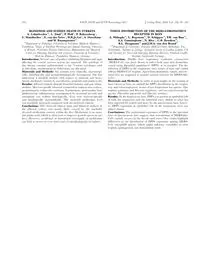
2018 Tissue Distribution of the Mers-Coronavirus Receptor in Bats PDF
Preview 2018 Tissue Distribution of the Mers-Coronavirus Receptor in Bats
BLINDNESS AND SUDDEN DEATH IN TURKEYS A. Lehmbecker*, L. Zind*, P. Wolf y, P. Bahrenberg z, C. Mandischer z, E. van der Vries x, W.K.J�o Lei x, A. Osterhaus x and W. Baumg€artner* *Department of Pathology, University of Veterinary Medicine Hannover, Foundation, yChair of Nutrition Physiology and Animal Nutrition, University of Rostock, zVeterinary Practice G€uterstrasse, Hamminkeln and xResearch Center for Emerging Infections and Zoonoses, University of Veterinary Medicine Hannover, Foundation, Hannover, Germany Introduction: Several cases of poultry exhibiting blindness and signs affecting the central nervous system are reported. The aetiology of this disease remains undetermined so far. Various aetiologies such as infections, intoxications or deficiencies are discussed. Materials and Methods: Six animals were clinically, macroscopi- cally, histologically and immunohistologically investigated. The diet underwent a detailed analysis with respect to minerals and heavy metals, methanol, vitamin A, coccidiostats, pesticides and amino acids. Results: Affected animals showed disturbed balance and gait abnor- malities. Macroscopically bilateral symmetrical malacia was evident, predominantly within the cerebrum. Furthermore, perivascular lym- phohistiocytic inflammation accompanied by neuronal necrosis and astrogliosis was evident histologically. Eyes were macroscopically and histologically unremarkable. The analyzed methionine level was markedly increased compared with the declared content. Conclusions: The observed clinical signs and bilateral malacia in the affected turkeys was mostly likely caused by the markedly elevated methionine content within the diet. Methionine is an essen- tial amino acid, which is often used to improve growth curves in tur- keys. However, accidental or intentional oversupply of methionine can lead to severe or even fatal cases of encephalopathy in turkeys. TISSUE DISTRIBUTION OF THE MERS-CORONAVIRUS RECEPTOR IN BATS A. Widagdo*, L. Begeman*, D. Schipper*, P.R. van Run*, A.A. Cunningham y, N. Kley z, C.B. Reusken*, B.L. Haagmans* and J.M.A. van den Brand* *Department of Viroscience, Erasmus Medical Center, Rotterdam, The Netherlands, yInstitute of Zoology, Zoological Society of London, London, UK and zInstitute for Novel and Emerging Infectious Diseases, Friedrich Loeffler Institute, Greifswald, Germany Introduction: Middle East respiratory syndrome coronavirus (MERS-CoV) has been shown to infect both man and dromedary camels using dipeptidyl peptidase-4 (DPP4) as its receptor. The dis- tribution of DPP4 in the respiratory tract tissues of man and camels reflects MERS-CoV tropism. Apart from dromedary camels, insectiv- orous bats are suggested as another natural reservoir for MERS-like- CoVs. Materials and Methods: In order to gain insight on the tropism of these viruses in bats, we studied the DPP4 distribution in the respira- tory and extra-respiratory tissues of two frugivorous bat species (Epo- mophorus gambianus and Rousettus aegyptiacus) and two insectivorous bat species (Pipistrellus pipistrellus and Eptesicus serotinus). Results: In the frugivorous bats, DPP4 was present in epithelial cells of both the respiratory and the intestinal tract, similar to what has been reported for camels and man. In the insectivorous bats, howev- er, DPP4 expression in epithelial cells of the respiratory tract was almost absent. Conclusions: The preferential expression of DPP4 in the intestinal tract of insectivorous bats suggests that transmission of MERS-like- CoVs mainly occurs via the faecaleoral route. Our results highlight differences in the distribution of DPP4 expression among MERS- CoV susceptible species, which might influence variability in virus tropism, pathogenesis and transmission route. 102 ESVP, ESTP and ECVP Proceedings 2017 J. Comp. Path. 2018, Vol. 158, 93e149
